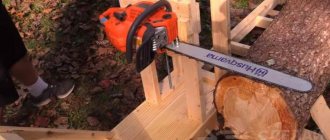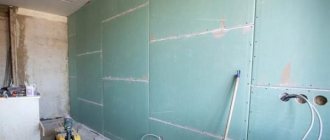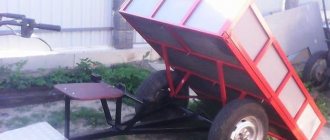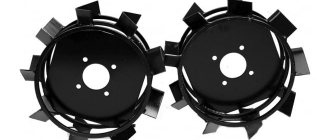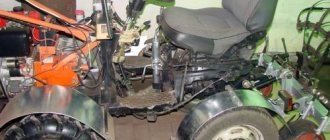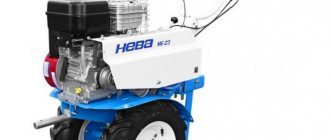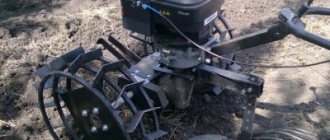Homemade products for walk-behind tractors are invented and made by almost all owners of this equipment. The purpose of these actions is to expand the functionality of the unit with minimal financial investment. In the basic configuration, the motor cultivator has extremely limited capabilities. Installing various options on it can turn a small machine into a full-fledged mini-tractor. Often, homemade devices are in no way inferior to factory-made analogues. In order to improve a walk-behind tractor with your own hands, a set of tools that are available in every workshop of a country house or cottage is sufficient. The materials you need can be found at a junkyard, shed, or scrap metal collection point.
Improvement of the chassis
The first thing users of a walk-behind tractor think about is how to make a cart with a seat for it. Using equipment in normal mode using levers requires the application of great physical effort. However, the use of a trailer reduces the stability of the vehicle. This problem can be eliminated by extending the wheelbase. This is done using extensions that are attached to the axle shaft with pins or bolts. Having solved the stability problem, the operator is faced with another issue: the unit is poorly controlled. The differential for the walk-behind tractor helps to give it good maneuverability. This device is made by analogy with components of passenger cars. Homemade unlockers for walk-behind tractors are made using ordinary household tools - an angle grinder, welding and a sharpening machine.
The low weight of the walk-behind tractor causes poor traction between the wheels and the ground. Slipping is a common occurrence when lifting virgin soil, working on wet ground or driving in snow. To avoid slipping, weights are attached to walk-behind tractors.
These devices are divided into the following categories:
- Wheeled. They are discs that are mounted on wheels or hubs. Disks are made monolithic from metal, concrete or hollow, filled with sand. The weight of wheel weights can be 30-70 kg.
- External. Made from any heavy material (steel, lead, concrete). Attached to the body using hooks or bolts. Some craftsmen weld a frame from a corner to the body. Sandbags, bricks, scrap metal and other heavy objects are placed in it.
You can improve the cross-country ability of a walk-behind tractor by installing lugs. The easiest way to make lugs is to make a rim from a strip of metal and weld blades onto it. The rim diameter should be larger than the rims and smaller than that of the tires. The rim is installed with flat tires. After the lug is installed, the wheel is inflated.
You can improve the transmission by installing a homemade variator on the engine. The system of belts and discs will allow you to smoothly change the speed of the unit, without jerking or vibration.
Wheel lugs
Lugs are a modified group of wheels that do not have tires or tubes.
The main purpose is to carry out work in the fields (the key value is adhesion to the soil).
They mean steel wheels with special external inserts that provide significant assistance when moving.
Kum 680 wheels for hilling
A distinctive feature is the presence of:
- solid rim;
- the spikes protrude 7 cm.
Wheel sizes of the Neva walk-behind tractor of this modification:
- diameter along the spikes – 43 cm;
- rim diameter – 35 cm.
The width of the lug is 20 cm.
The total weight of the structure is 16.5 kg.
Installation is carried out on the gearbox shaft - no additional connections are provided.
Universal wheels Kum 540 for hilling
A distinctive feature from the 680 model is not a solid rim, but the presence of only a side - it is full inside. In addition, the spikes do not have an inclination to one side, but have a V-shape.
When moving into the ground, traction with the ground is provided not only by the studs, but also by the rim itself, due to which the maximum effect is achieved.
Diameter is:
- along external spines - 54 cm;
- along the rim – 46 cm.
- width – 9 cm.
Universal wheels Kum 540 with long hub
KUM 540 is often used for hilling, but the bushing is already installed - it is connected directly to the gearbox shaft.
An additional distinctive feature is the width of the stake, which can reach 68 cm.
Main characteristics:
- number of hoops – 2 pcs.;
- diameter along the wheel at the studs – 540 mm, at the hoop – 460 mm. Spike width – 90 mm;
- The bushing diameter is 30 mm.
Installation is carried out on the gearbox shaft. The total weight does not exceed 13.5 kg.
H lugs for plowing
Features include large diameter and width. They are used when it is necessary to work with virgin soil or plots after winter inactivity, when the surface is still hard and requires preparation.
Characteristic:
- width – 20 cm;
- diameter along the spikes - 43 cm, along the hoop - 35;
- spike height – 8 cm.
Provide the best cross-country ability for your equipment. Installation is possible on the shaft of the Neva walk-behind tractor or on extensions - depending on the specific situation.
In the case of direct installation, the track width will be 40 cm; when using an extension, it will vary from 65 to 70 cm.
Mini H lugs for plowing
The lugs for Neva cultivators are similar to the KUM model range.
Main characteristics:
- wheel diameter – 32 cm;
- width – 16 cm;
- pair weight – 8 kg.
The best option for plowing soil.
H lugs for plowing with long sleeve
Full identity with the considered model range. The only difference is the presence of an already mounted bushing.
In this modification, the track size is fixed - 65 cm.
Mini H lugs for hilling
Today they are considered one of the lightweight MINI N models for plowing. During hilling, the soil is already prepared and not hard, which is why there is no need for a massive type.
The diameter of the hoop is set to 28 cm, and the width for hilling is 9 cm.
Weight does not exceed 4.85 kg.
Designed for use in summer and winter.
Reducing noise from the unit
Even the most modern and expensive motor cultivators make a lot of noise during operation, especially at high speeds. This factor greatly tires the operator and can serve as a reason for deterioration of relations with neighbors. A homemade muffler will help solve the problem. This is a task that can be accomplished by any craftsman with basic skills in handling iron.
In order to make a muffler for a walk-behind tractor with your own hands, you will need the following tools and materials:
- roulette;
- welding machine;
- Bulgarian;
- electric drill;
- hammer;
- aluminum clamp;
- stainless steel 2 mm thick;
- metal shavings.
Having collected everything you need, you can begin to improve the exhaust system.
This is done in the following sequence:
- Make 2 oval pipes from stainless steel. The diameter of the pipes should differ by 1-1.5 cm. The pipe joints should be fastened using a welding machine.
- In a pipe of smaller diameter, make a maximum number of holes with a diameter of 8 mm. Wrap it with metal shavings. Wrap the shavings with steel wire.
- Insert the smaller pipe into the larger one. Fix them in the desired position using steel rods and welding.
- Attach the muffler to the exhaust pipe and secure with a clamp.
The noise level after such an improvement will decrease several times. The service life of a homemade muffler will be at least 5 years. So, being content with little, you can significantly improve the conditions for carrying out agricultural and other work using a walk-behind tractor.
Tools and materials
Regardless of the extent to which the walk-behind tractor is planned to be modernized, the following devices will be required for this work:
- welding machine;
- grinder with blades for cutting and grinding iron;
- electric drill;
- screwdriver;
- roulette;
- oil level;
- soldering iron;
- Screwdriver Set;
- core;
- hammer.
As a rule, all this is in the workshop of every owner of a summer house, country house or small farm.
To make an all-wheel drive tractor from a walk-behind tractor, you need to find or buy the following materials:
- steel angle 50 mm;
- sheet steel 3-4 mm thick;
- wires for lighting devices;
- wheels from a passenger car (2 or 4);
- solid hexagonal steel profile;
- iron wire 1 mm;
- seat with steel frame;
- headlight and side lights from a moped or motorcycle;
- generator or portable battery.
Most of this property can be found at a landfill or scrap metal collection point. Iron is given a presentable appearance by treating it with acid, a grinder and an anti-corrosion compound.
Blade for walk-behind tractor
The blade is a necessary device, which is needed at any time of the year. The front blade is used to clear snow, plan terrain, dig holes and move bulk materials. Such equipment for the Neva walk-behind tractor is of good quality, but not everyone can afford it. Do-it-yourself dumps require minimal financial investment. By installing the front blade on the Neva walk-behind tractor, you can solve many household problems. If there are levers and hydraulics, a homemade shovel can also be used as a loader.
To make a blade you will need the following tools:
- roulette;
- welding machine;
- electric drill;
- Bulgarian;
- spanners;
- acrylic paint;
- barrel 200 l;
- reinforced rubber;
- sheet steel 5 mm;
- profile pipe 40x20 mm;
- paint and brush;
- bolts and ties.
Before making a blade, it is necessary to calculate the compliance of the power of the walk-behind tractor with the dimensions of the bucket. Excessive load leads to rapid wear of parts and mechanisms of the unit. Depending on the weight and power of the machine, shovels are made 60-100 cm wide and 20-30 cm high.
Do-it-yourself snow removal for a walk-behind tractor is made in the following sequence:
- Applying markings to the barrel, sawing it into 3 equal parts vertically. Cutting 1 piece into strips 5 cm wide.
- Fastening 2 workpieces using bitumen and rivets. Aligning the edges of the product. Reinforcement of the bucket with transverse racks.
- Fastening strips of tin along the edges of the shovel. This is done by welding or bolts.
- Drilling holes for bolts. Attaching a strip of rubber to the bottom of the bucket.
- Making a hitch for a shovel. It is made by welding a piece of pipe and a semicircle of sheet metal to the blade. Holes are made on the sector to adjust the angle of attack. A homemade snow removal device is attached to the bracket of the walk-behind tractor with an adapter made of a profile pipe.
The finished product needs to be cleaned and painted. All bolted connections must be lubricated regularly to prevent corrosion.
Headlight and dimensions for walk-behind tractor
Almost all owners of land plots have to decide how to make light on a walk-behind tractor. Very often you have to work late or drive modernized equipment in the dark. Without path lighting, it is not only inconvenient, but also dangerous.
There are the following options for installing headlights and dimensions for the Neva walk-behind tractor:
- From the generator. A standard product or a generator from a passenger car is used. To prevent the light from dimming when the speed decreases, it is better to take a generator from a tractor. The part is installed on a bracket welded to the frame.
- From the battery. If the unit is heavy, it is better to use a battery from a moped or outboard motor. It is advisable to install batteries from passenger cars on light walk-behind tractors. They will not only provide a long-lasting glow, but will also press the wheels to the ground.
Potato digger for walk-behind tractor
Potato diggers of various types are very popular among farmers. These devices save people from hard manual labor, speeding up the harvesting process several times. The walk-behind tractor has a very simple design. It can be made from metal that remains after the construction and renovation of a house.
To work you will need:
- Bulgarian;
- welding machine;
- electric drill;
- heavy hammer;
- anvil;
- profile steel pipe 20x40 mm;
- reinforcement 12 mm;
- tin (preferably stainless);
- bayonet shovel without handle.
The attachment to the walk-behind tractor is made in a suspended or trailed (modular) design. The hanging tool only digs up the tubers, leaving them lying on the surface for subsequent manual harvesting. A modular potato digger not only extracts the crop from the ground, but also collects it in a mobile container on a chassis.
The manufacture of a digger is carried out in the following sequence:
- Drawing up a drawing. The width of the digger should be within 25-30 cm. The angle of attack of the tip is taken perpendicular to the coulter so that the tool does not bury itself in the ground.
- The reinforcement is cut into fragments of a given length. Using a hammer and anvil, they are given the required bend.
- A container for tubers is assembled from a profile pipe and tin. The chassis or skids are welded to the container frame. The runners are made from pipes, and the chassis is taken from an old stroller, cart or lawn mower.
- The holder and reinforcement bars are welded to the shovel. A drawbar is welded to the holder, which is fixed to the assembly container. Connections are made movable using bolts or hinges.
- Rust and weld marks are removed. The finished product is treated with an anti-corrosion agent and coated with paint.
Adjustment and adjustment of the digger is carried out using racks and steel ties.
Included with the digger, you can immediately make a disk hiller. This tool will be needed when planting tubers after they have been buried in a trench made by a plow. Hillers are made from old pot lids, profile pipes and bolts. A trolley is assembled from pipes and small wheels, onto which holders for lids are welded at a certain angle. After sharpening on a stone, the discs are mounted on holders.
Basic faults
Belt adjustment and dimensions
For the Neva MB-2 walk-behind tractor, the A-1180 drive belt is used. This model uses one belt that provides forward movement.
In other modifications of the Neva MB-2 model, two drive belts are used. Reverse gearing occurs in the gearbox itself.
Replacing the belt for MB-2 walk-behind tractors is carried out in the following sequence:
- The shield is removed, and then the pulley protective cover.
- The spring from the walk-behind tractor rod is removed to loosen the belt.
- The screws securing the bracket are turned.
- The bracket rotates to a position in which the limiting pins do not prevent the part from being removed from the pulley.
- The pulleys are adjusted, and then a new belt is installed.
- Pull the belt onto the gear shaft pulley, and then onto the motor pulley.
- In reverse order, place the remaining parts in their places.
Replacement of gearbox seals
The oil seals in the Neva MB-2 walk-behind tractor are replaced if an oil leak is detected.
This condition is dangerous because the walk-behind tractor gearbox may be left without oil, and this will lead to rapid wear of the unit.
The sequence for replacing oil seals is as follows:
- Remove the cutters from the shaft, cleaning the shaft and covers from dirt and oil residues.
- Unscrew the cover bolts, tap off the oil and debris, and remove the cover from the gearbox.
- The old oil seal is replaced with a new one and wiped dry.
- The cover is returned to its place (if necessary, it is placed on sealant) and fixed with bolts.
Adjusting and tuning the Neva MB-2 carburetor
Neva MB-2 device
The functionality and durability of the walk-behind tractor engine depends on the stable operation of the carburetor. This is why its adjustment and tuning are so important. In addition, if the carburetor is incorrectly configured, a gasoline walk-behind tractor may experience increased fuel consumption
The carburetor of the Neva MB-2 walk-behind tractor is adjusted as follows:
- The full throttle and idle screw are turned to the limit.
- Both screws are unscrewed 1-1.5 turns.
- Next comes starting and warming up the engine.
- The throttle control lever is placed in a position in which the engine will operate at minimum speed.
- Set the minimum idle speed until the unit operates stable.
- The idle speed is set to maximum.
- The minimum idle speed is adjusted.
- Steps 6 and 7 are performed until the engine runs smoothly (more smoothly by ear) at idle speed.
For long-term and uninterrupted operation of the walk-behind tractor, it is necessary to regularly perform engine diagnostics, monitor the frequency of oil changes, and also comply with operating conditions and time intervals for scheduled maintenance.
Adjustment of valves
Adjusting the valves is a fairly simple procedure that requires wrenches, screwdrivers and a feeler gauge. The valve adjustment process is needed to establish optimal and technically correct clearances between the valves of a walk-behind tractor engine. Adjusting valves using the example of the Neva MB-23 walk-behind tractor (the principle is the same for everyone)
The adjustment sequence is as follows:
- remove the casing that covers the engine;
- remove the valve box cover;
- make adjustments (see below);
- Reinstall the valve box cover;
- Replace the casing.
Manufacturing a field sprayer for a walk-behind tractor
A homemade sprayer for a walk-behind tractor is necessary in cases where the area of cultivated crops exceeds 20 acres. Doing this type of work manually is very difficult and can take a whole day. Mechanization of this process will save a lot of time and effort.
To make a sprayer you will need:
- welding machine;
- Bulgarian;
- level;
- electric drill;
- soldering iron for polypropylene pipes;
- profile or round water pipes;
- plastic or steel barrel with a capacity of 80-100 l;
- wide pneumatic wheels;
- plastic pipes;
- rubber hose;
- injectors or nipples from wheel tubes.
Assembling a homemade sprayer is carried out in the following sequence:
- Making the frame. Its dimensions are adjusted to the size of the container. The chassis is attached to the frame. For good cross-country ability you need at least 4 wheels. In the absence of wheels, wide skids are made of aluminum.
- The container is installed and secured on the frame. For this purpose, spacers and ties are used. Holes are made in the tank for supplying high-pressure hoses. The tank neck is sealed.
- A bracket for the pump is being manufactured. A model is selected that operates from a power take-off shaft (belt drive) or from electricity (motoblock generator).
- The irrigation system is being assembled. A durable holder is made from steel profiles. Plastic pipes are attached to it using clamps or plastic ties. A valve is being installed to bleed off excess pressure and injectors.
- All parts are connected together, the quality of the fastenings and the tightness of the joints are checked. The tank is filled with water, the unit is tested in various modes, and final adjustments and settings are performed.
A self-made sprayer will fully justify the efforts invested in the first season. Thanks to this device, spraying and watering the garden will be done quickly and efficiently.
We make a cultivator
A homemade cultivator for a walk-behind tractor is made from a steel sheet measuring 150x150 mm. The cutter is made of 250x40 mm plates. The plates are connected in pairs in the form of a cutter. They are usually secured with bolts. Next, two metal pipes are taken, which are connected to each other with ready-made cutters. The entire structure is attached to the walk-behind tractor shaft.
Homemade variator for walk-behind tractor
The variator allows you to smoothly change speed without sudden jerks, saves fuel by transmitting torque. Motors from a walk-behind tractor are often used as a generator to provide electricity to living quarters, local areas, and also to operate lathes.
A homemade variator can be made in different ways, the easiest way is to use a ready-made variator, which can be converted for a specific walk-behind tractor. Another way is to use ready-made parts from gearboxes and other mechanisms. You can also make parts yourself, provided you have special equipment (discs require hot stamping). Diagrams and videos for creating parts and assembling pulleys are easy to find on the Internet.
You can make a variator from wheel hubs, the main thing is to make a hole diameter suitable for the crankshaft. In addition to pulleys, a variator requires a belt, which is one of the most important parts. The belt must be strong, and all parts of the variator must be lubricated regularly.
Owner reviews
Nikolay, 33 years old:
Hello. I am the owner of the OKA 1d1m10 walk-behind tractor. My mini tractor (that’s what I call it) will be 5 years old this year. The machine is strong, time-tested, and simply irreplaceable on a plot of land. He processes my 32 acres without effort. The controls are very simple; breakdowns, of course, do occur, but the benefits far outweigh the temporary inconvenience. Mostly belts fly, the gas tank cap gets lost (jumps off). The machine is noisy, but it completely performs all gardening work. Compact dimensions allow it to fit into a raspberry patch and even into a greenhouse.
Homemade loader from a walk-behind tractor
A loader made from a walk-behind tractor is a necessary thing in the household. Buying a ready-made loader is very expensive; this is only necessary if there is constant work involving transporting goods, clearing terrain, etc. Loaders are mainly used in households for clearing snow and transporting various goods, so it would be cheaper and more efficient to make a forklift yourself.
Craftsmen are constantly coming up with new versions of this equipment, so there are many modifications, among which there is a suitable option for everyone. The loader can be assembled from special parts, or you can use what many people have in their garages. Parts from old cars and motorcycles are suitable.
The walk-behind tractor must be equipped with a powerful engine. The heavier the loads, the more powerful the equipment should be. Even walk-behind tractors with 15 hp motors. lift no more than 250 kg. A counterweight is required.
You can take the drawings of a fracture mini-tractor as a basis. The frame is made of a channel, the fracture unit is a fist from a VAZ, the steering column and shortened axles are from any car, the P40 hydraulic distributor, the bucket can be made independently, or you can use a ready-made one.
Required parameters
When making homemade products for a walk-behind tractor, it is important to consider factors that will allow the equipment to work correctly. You cannot assemble a unit like your neighbor’s, who works on a tractor, and connect it to a walk-behind tractor. The parameters of the equipment and attachments must be appropriate. Therefore, it is necessary to pay attention to the following points:
- Motoblock power. So, for equipment with a capacity of 4.5 liters. With. A load of 250 kg including the driver will be sufficient. Based on this value, you can calculate the mass of cargo transported in the trailer, the number of permissible plows, and so on.
- Size. The area near the house, even the largest one, is still not a field. Therefore, there will probably be areas where large equipment will not fit. In addition, large (or, conversely, narrow) equipment is not always convenient to use. It may not fit between the trees or, conversely, be too narrow for the garden bed. It is necessary to take into account such dimensions in advance.
- Provide a unit for attaching equipment to the walk-behind tractor. It can be hinged, on bushings, or bearing. You need to select it specifically for your equipment.
- A method of fastening individual parts of equipment to each other. Solid units can be connected to each other by welding, rivets, and bolts. The choice in this case depends on the availability of tools, time and abilities.
These are the main questions that need to be thought through. But not the only ones. In the process of making a homemade product for a walk-behind tractor, there will be many questions and nuances that will need to be carefully considered in order to make the right decision.
Homemade products for the Neva walk-behind tractor
Attachments and trailed equipment significantly expand the functionality of walk-behind tractors. Some equipment is included, for example, cutters, but the rest must be purchased. If you purchase the entire arsenal of additional devices for the Neva walk-behind tractor, it will be too expensive, which is why homemade products and inventions from improvised means are so in demand.
What accessories for a walk-behind tractor can be made at home?
- Rake
- Hillers
- Plow
- Seeder
- Milling cutters
- Shovel
- Adapters, trolleys
- Mowers
There are detailed articles and videos on the Internet on how to make these devices. Another important improvement for the walk-behind tractor is the muffler. It comes standard as part of the exhaust system, but does not always suppress noise. You can make a quiet muffler using this scheme:
Features of the Neva MB-23S-9.0 walk-behind tractor with a 9 hp Subaru EX27 engine: video of use
Among all engine options for walk-behind tractors Neva, Subaru 9 hp. is the heaviest and most powerful. A model with such an engine is perfect for solving a wide range of tasks and can be used regardless of the time of year.
A distinctive feature of the engine for the Neva Subaru walk-behind tractor with 9 horsepower is the ability to use any type of attachment. In addition, the MB-23 model is characterized by a reinforced gearbox design, on which an additional cutter can be installed on each side. This allows you to simultaneously cultivate a plot of land up to 170 cm wide.
There are also several other reasons for purchasing such a model. If you decide to buy a Neva Subaru EX27 walk-behind tractor, you will save significantly on fuel for the unit. A special balancing device effectively suppresses vibrations and reduces noise during operation. The model starts up equally easily both at above-zero temperatures and in cold weather.
What can be made from a walk-behind tractor
The use of specialized equipment allows you to solve a wide range of problems. However, some owners want to get even more functions from the walk-behind tractor.
Do-it-yourselfers are constantly inventing something and showing what can be made from a walk-behind tractor. Upgraded adapters turn into mini-tractors; you can also create a snowmobile, swamp vehicle, or ATV. By replacing the wheels with caterpillar tracks, you get a motorized towing vehicle.
These and many other amazing homemade products, methods for creating them, drawings, etc., are available at the link:
Modernization of walk-behind tractor. TOP 7 ideas for tuning a walk-behind tractor
For those who bought a Neva walk-behind tractor, reworking and modernizing this unit becomes an urgent task after the first season of operation. Despite the fact that domestic equipment is durable and reliable, it is quite difficult and not very convenient to work with. Refinement of the Neva walk-behind tractor will not only reduce the load on the operator, but also significantly expand the capabilities of the machine. A specialized workshop will also help you tune the walk-behind tractor, but the cost of such work may exceed the price of the equipment itself. You can convert a heavy motor-cultivator into a multifunctional mini-tractor yourself. This will require a minimal financial investment. All that is needed in order to carry out a major overhaul and modification of the Neva walk-behind tractor is time and the ability to use household tools correctly.
DIY walk-behind tractor
The advantage of a homemade walk-behind tractor is its price. If it is assembled with high quality, its characteristics will not be inferior to the factory ones.
It is necessary to determine which area will be processed by the walk-behind tractor, and what characteristics the soil has. This determines how powerful the engine should be.
The motor will fit from other agricultural equipment (from a chainsaw), but in this case it is necessary to supplement it with a forced cooling system. It is also necessary to create a frame to which the engine, wheels, and handle will be attached.
More detailed information on how to make a walk-behind tractor with your own hands can be found here:
Neva walk-behind tractor with caterpillar drive
Although Neva walk-behind tractors are equipped with wheels as standard, you can buy a tracked attachment for your unit. Neva crawler walk-behind tractors differ from their wheeled counterparts in their increased maneuverability in rainy or snowy weather and allow the unit to be used at any time of the year. You can buy tracks for Neva walk-behind tractors, or you can make them yourself using improvised means.
Neva walk-behind tractors with a caterpillar drive have high maneuverability and can be used in adverse weather conditions
Making caterpillars with your own hands
If you don’t want to buy a caterpillar drive for Neva walk-behind tractors, but make it yourself, then for this you will need the following materials:
- the walk-behind tractor itself, equipped with an axle locking function and a 4-stroke engine;
- transport tape or a pair of large-diameter car tires for making tracks;
- a pair of extra wheels.
Related article:
Which walk-behind tractor is better: prices, reviews and characteristics of this type of equipment
Information about what types of units are available and how to choose the most suitable model. A brief overview of the characteristics of various walk-behind tractors.
The simplest version of tracks for the Neva walk-behind tractor, reviews of which indicate the high efficiency of the design, is a design made from a transport belt. To make it, you will need a tape with a thickness of at least 7 mm, as well as an additional wheel on each side of the unit. To make the tape track last longer, you can stitch it along the edge with thick fishing line.
Helpful advice! Additional wheels for a crawler walk-behind tractor can be taken from an old car. The main thing is that they exactly match the original wheels in diameter.
To make caterpillars with your own hands, it is better to use old car tires.
Also, a tracked unit from a Neva walk-behind tractor with an American or Japanese engine can be made using car tires. For this you will need tires with a large diameter and the correct tread pattern. It is best to choose tires from a tractor or large truck for this. The process of making tracks from tires is divided into the following stages:
- Cutting tracks for tracks in tires. To do this, you can use a special shoe knife, which must be moistened with a soap solution to facilitate the process of cutting rubber.
- Cutting off the side part from them. This can be done with a fine-toothed jigsaw.
- Removing excess parts from the inside of the tire.
The advantage of tracks made from car tires is their increased strength and reliability due to their solid structure. The disadvantage follows from the advantage and is that the length of such a track is strictly limited by the length of the tire.
In addition, tracks for walk-behind tractors can be made from belts or chains. In the first case, it is necessary to connect several belts with a wedge-shaped profile to each other. The connection is made using lugs and rivets. For the second option you will need two chains of the same size.
When installing tracks on a walk-behind tractor, use a water-cooled engine
Before making tracks for the Neva unit, you need to correctly calculate their parameters. If the caterpillar is too high, the walk-behind tractor may tip over when turning. In addition, when installing tracks, it is better to choose a water-cooled engine model, since this design puts a greater load on the engine and can lead to overheating.
Do-it-yourself jack for a walk-behind tractor
A jack is necessary for the convenience of carrying out repair work: replacing a wheel, installing lugs, etc. The scissor type is suitable for walk-behind tractors. Drawings and photos with step-by-step instructions for creating a jack can be easily found on the Internet.
A scissor-type jack can be created by converting a screw jack, or it can also be made from specially created parts. Both options are easy to implement and require minimal costs. However, special equipment is required - an angle grinder, a drill, a welding machine.
The basis of such a device is represented by two identical frames, to which metal plates installed crosswise are welded.
Do you use homemade products for walk-behind tractors?
Power plant tuning
Its power and equipment performance depend on the stability of the engine. Upgrading a standard engine is very expensive and unpromising. But, there are several ways to make the engine more efficient.
- Install a quality spark plug. Regularly clean it from carbon deposits and periodically check the clearance. At the first sign of loss of power, replace the spark plug.
- Use the best gaskets on all connections. This allows you to maintain the required pressure in the unit, preventing a decrease in power and the formation of smoke during operation.
- Fill the engine with the best oil to the upper mark. It should be remembered that when the unit is tilted, oil flows away from the rubbing parts.
- Check the quality of fuel before filling the tank. It is advisable to let it sit for a while so that the water sinks to the bottom of the container. The tank itself must be cleaned and wiped dry every 2-3 days.
- Install an additional radiator. To do this, steel plates are welded to the engine housing, which will effectively remove excess heat.
A radical solution is to replace the power plant with a more powerful and advanced one. Today you can purchase Japanese, Chinese and European engines, which are characterized by high performance and reliability. It is possible that the frame will have to be redesigned to accommodate the new power plant.
Manufacturing of additional accessories
Walk-behind tractors go on sale assembled and with minimal equipment. A plow and a cutter are clearly not enough to perform the entire volume of agricultural work. A factory kit for converting a walk-behind tractor can cost more than the unit itself. You can make various attachments and trailers from scrap materials, using tools that are in every pantry of a country house or cottage.
Drawing of cutters for a walk-behind tractor Drawing of a plow for a walk-behind tractor Drawing of a trolley for a walk-behind tractor
It is worth considering some options for making additional equipment yourself:
- A converted rake for collecting grass clippings, debris, branches and fallen leaves. If you do this work manually, it will take a lot of time and effort. Trailed equipment will allow you to clean large areas within a few minutes. To work, you will need a wide strip of sheet iron and several meters of reinforcement with a cross section of 8-12 mm. The reinforcement must be cut into pieces 10 cm long and welded to the plate in several rows and at intervals of 3-4 cm. Long rods are welded to the plate for attaching to the walk-behind tractor frame. Trailed rakes can be equipped with rollers to improve maneuverability and smoothness.
- Snow plow. Most units operate much more efficiently in the cold because they do not overheat. You can mechanize snow removal in winter. The blade is made from two pieces of channel welded together. This allows you to get a gripping height of up to 40 cm. The width of the blade is selected according to the power and weight of the unit within 40-80 cm. The blade is attached rigidly to the front of the machine with bolts. Initially, it can be mobile or stationary.
- Trolley and trailer. The walk-behind tractor cannot be driven on the road, so it does not have to be adjusted to the requirements of the traffic rules. The cart is made from a corner, a channel and old wheels from a small car, and a trailer is attached to it. It is made from metal profiles and boards. The towing clutch is made standard, like for cars or tractors.
Increased speed and maneuverability
These questions are relevant for those who have to work on heavy and damp ground, on ups and downs. Even the most advanced models can slip, forcing the operator to exert additional effort to push the machine forward. Many people are not satisfied with the speed of the unit when towing equipment or transporting various loads.
There are several ways to solve these problems:
- Increase wheel diameter. Most walk-behind tractors are equipped with wheels with a diameter of 25-30 cm. If you install 45-50 cm wheels from an old small car, the speed of the unit will double. But you should not make a racing car out of a walk-behind tractor, since this device is not highly durable and has good stability. You can accelerate to 25-30 km/h only on a flat road without sharp turns.
- Manufacture and install weighting materials. For such factory-made devices in the store you will have to pay a large sum. It is better to make them yourself from scrap materials. Weights are placed on the wheels and on the frame. The wheel weight is made of steel wheels and a hexagonal solid profile. The welded parts are inserted into the hubs with a hexagon and secured with cotter pins in the drilled holes. Instead of iron disks, you can use reinforced concrete blanks or flat round flasks with a neck, into which sand is poured. The body of the walk-behind tractor is weighted using removable frames from the corner. Loads of various weights and configurations are already screwed to the frame.
- Secure the tracks. This solution will allow you to turn the walk-behind tractor into a full-fledged low-speed snowmobile. It is enough to install another axle with wheels and purchase wide rubber tracks. Stoppers need to be attached inside the tracks to prevent them from jumping off the wheels. A homemade snowmobile can also be useful in the spring, when the soil is wet and the terrain is impassable for conventional equipment. As a kit for a homemade snowmobile, you can make a sled for transporting various property through the snow, going hunting, fishing, or to the nearest store after a snowfall.
There are many opportunities for radical transformation of even a small domestically produced walk-behind tractor. This equipment can be transformed into any agricultural implement and off-road vehicle.
